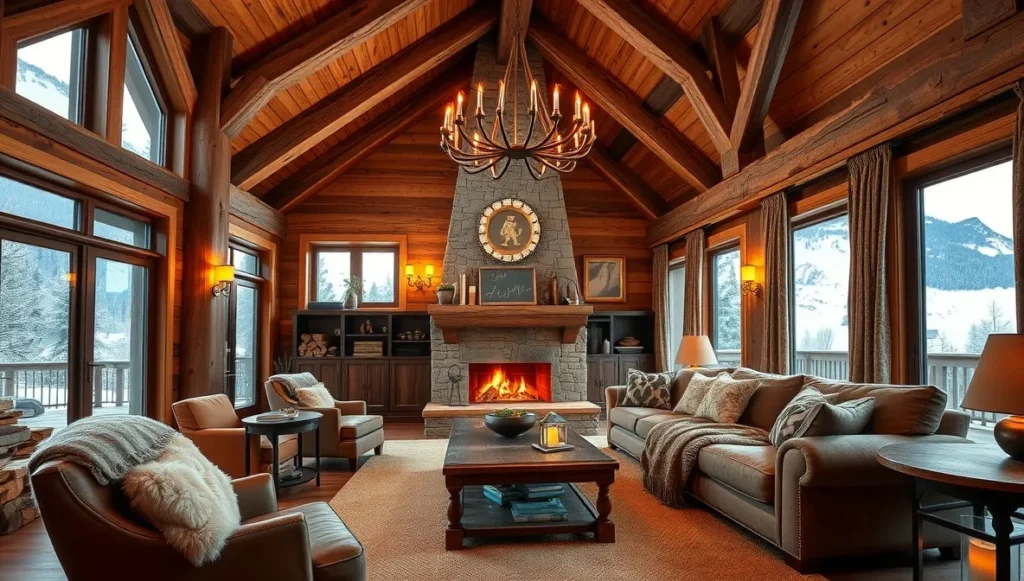- Bauhaus Interior Design: Why This 100-Year-Old Style Still Works Today - September 6, 2025
- Southwestern Interior Design: What I Wish I’d Known 20 Years Ago - September 6, 2025
- Why Norwegian Interior Design Actually Makes Your Home Feel Like Home - September 4, 2025
Table of Contents
I fell in love with Alpine chalet design during a winter in the Swiss Alps fifteen years ago. Staying in a 200-year-old chalet outside Zermatt, I realized this wasn’t just interior design. It was survival made beautiful. Everything served a purpose, but somehow every functional element looked like it belonged in a design magazine. I actually captured the chalet that started it all – take a look.
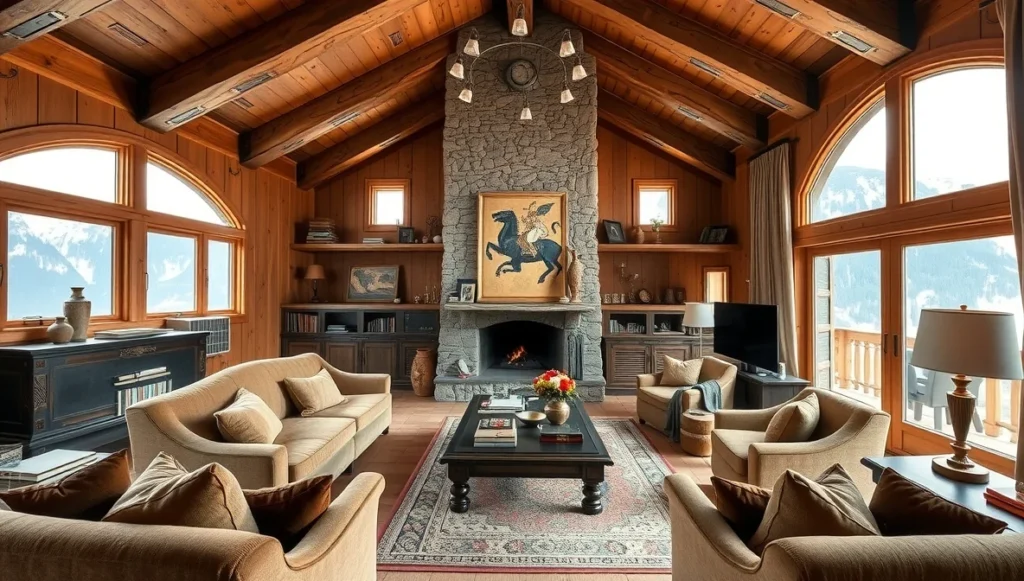
What Alpine Chalet Design Really Means
Most people think Alpine chalet style means slapping some fake antlers on the wall and calling it rustic. Wrong. Real Alpine design evolved from centuries of mountain living where every design choice meant the difference between comfort and misery during brutal winters.
I’ve worked on chalets from Aspen to the French Alps, and the authentic ones share certain truths. Everything centers around warmth. Not just physical warmth, but emotional warmth too. These homes make you want to kick off your boots, pour some wine, and settle in for a long conversation by the fire.
True Alpine chalet design focuses on natural wood construction, stone foundations, cozy textiles, efficient heating solutions, and furniture built to last generations.
The Essential Elements That Make It Work
Wood, Wood, and More Wood
Alpine chalets live and breathe wood. But not just any wood. We’re talking about massive timber construction where you can see the craftsmanship in every beam and joint.
During a renovation in Vail, we exposed original hand-hewn beams that had been hidden under drywall for decades. The homeowner nearly cried when she saw them. Each beam still showed the marks from the broadaxe that shaped it over a century ago.
Different woods serve different purposes. Pine and fir for structural elements because they’re strong and abundant in mountain forests. Walnut or cherry for furniture because they age beautifully. Larch for exterior elements because it weathers to gorgeous silver-gray.
The key is letting wood look like wood. No glossy polyurethane finishes that make everything look like bowling lanes. I prefer natural oils that enhance the grain while letting the wood breathe and develop character over time.
Stone That Grounds Everything
Every authentic Alpine chalet I’ve seen uses local stone. Makes sense when you think about it. Why haul materials up a mountain when perfectly good building stone sits right there?
Stone serves as the foundation, literally and visually. Massive stone fireplaces anchor living spaces. Stone floors in entryways handle wet boots and melting snow. Stone accent walls add thermal mass that helps regulate temperature.
I always source stone locally, even for non-mountain projects. Colorado river rock for a Denver home. Fieldstone from local farms for a Vermont project. The stone should feel like it belongs to the landscape, not like it was shipped from some quarry on another continent.
Textiles That Fight the Cold
Alpine textile traditions developed from pure necessity. Thick wool blankets, down comforters, fur throws. These weren’t luxury items. They kept people alive.
Modern Alpine chalet textiles honor this heritage while adding comfort. I layer like crazy: wool rugs over wide-plank floors, linen curtains under heavy wool drapes, down pillows mixed with wool throws on every seating surface.
My go-to textile sources include Swiss wool blankets (expensive but worth it), Pendleton blankets from Oregon (authentic Native American patterns), and vintage European linens when I can find them.
Furniture That Works as Hard as It Looks
Seating Built for Gathering
Alpine furniture prioritizes function over fussy details. Deep sofas with sturdy frames handle whatever weather-beaten hikers throw at them. Oversized chairs accommodate people wearing bulky sweaters. Everything gets built low and substantial.
I love finding vintage Alpine pieces at European antique markets. Hand-carved wooden chairs with rush seats. Massive oak tables that could double as workbenches. Armoires that started life storing wool and linens but work perfectly for modern storage needs.
Tables That Tell Stories
The dining table anchors every Alpine chalet. We’re talking serious furniture here. Thick wooden slabs that could survive an avalanche. Tables where families gathered for Sunday dinners, holiday celebrations, and long winter evenings when going outside wasn’t an option.
I recently installed a 12-foot oak table made from a single tree trunk in a Park City home. The clients initially worried it was too rustic. Six months later, they told me it’s become the heart of their home. Every scratch and wine ring just adds to its story.
Storage That Actually Stores
Alpine communities couldn’t run to Target for more storage bins. They built beautiful furniture that solved real problems. Massive armoires for clothing and linens. Wooden chests for seasonal items. Built-in benches with storage underneath.
Modern Alpine storage follows the same principle: make it beautiful enough to display but functional enough to actually use.
Room by Room: Making Alpine Work
Living Spaces That Welcome You Home
Alpine living rooms revolve around the fireplace. Everything else arranges itself around that central heat source. I position seating to face the fire while still allowing conversation flow.
Furniture sits low and substantial. Coffee tables made from reclaimed barn wood or tree slabs. Sofas deep enough to curl up in with a book. Side tables within easy reach of every seat for wine glasses and coffee mugs.
Lighting stays warm and dim. Table lamps with linen shades. Candles everywhere. Floor lamps with wooden bases. The goal is creating that golden hour feeling even when it’s blizzarding outside.
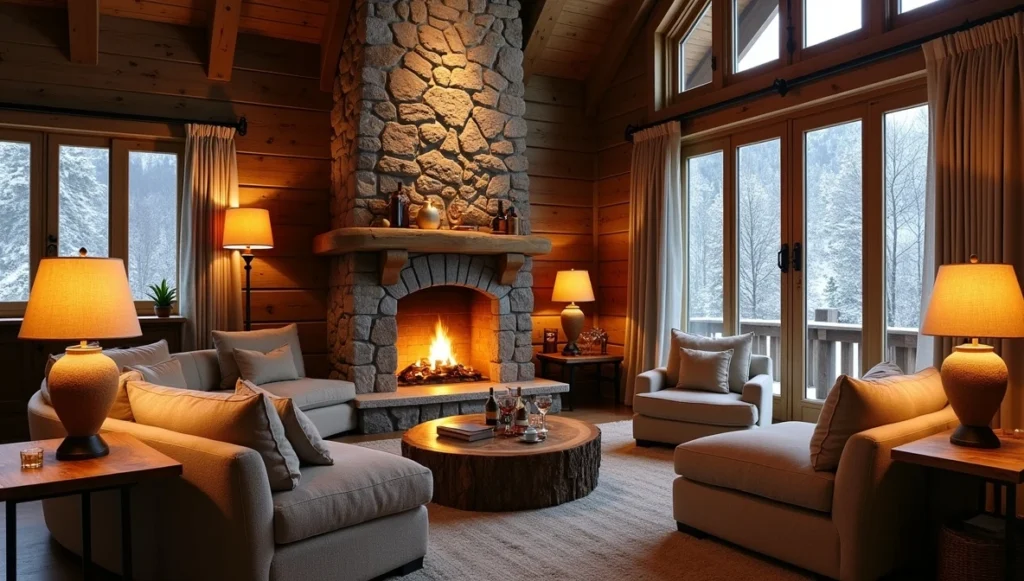
Bedrooms for Serious Sleep
Alpine bedrooms prioritize rest and warmth. Heavy wooden bed frames with thick mattresses. Down comforters rated for subzero temperatures. Multiple layers of wool blankets and throws.
I always include a reading chair by the window where clients can watch snow fall while drinking morning coffee. Wooden nightstands with drawers deep enough for books and reading glasses. Floors that feel warm underfoot, usually wide-plank wood with area rugs.
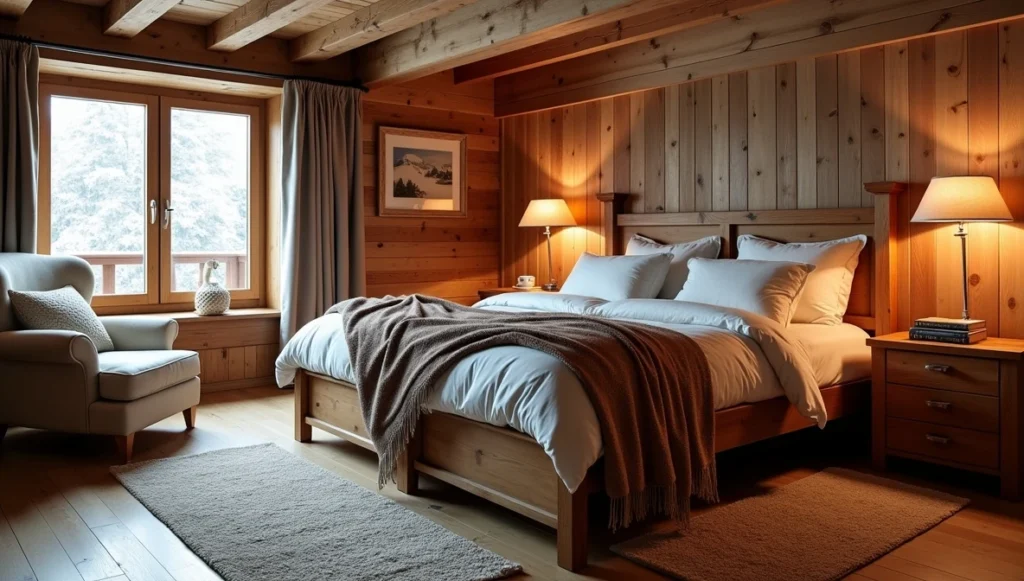
Kitchens That Feed the Soul
Alpine kitchens handle serious cooking. These homes often sit far from restaurants, so the kitchen becomes mission control for feeding family and guests.
Heavy wooden countertops that can handle hot pots and knife work. Deep farmhouse sinks for washing large platters. Open shelving that displays beautiful serving pieces and copper cookware.
I include a large wooden island that serves as prep space, casual dining spot, and gathering place during cooking. Bar stools with backs because people end up sitting there for hours, talking while the cook works.
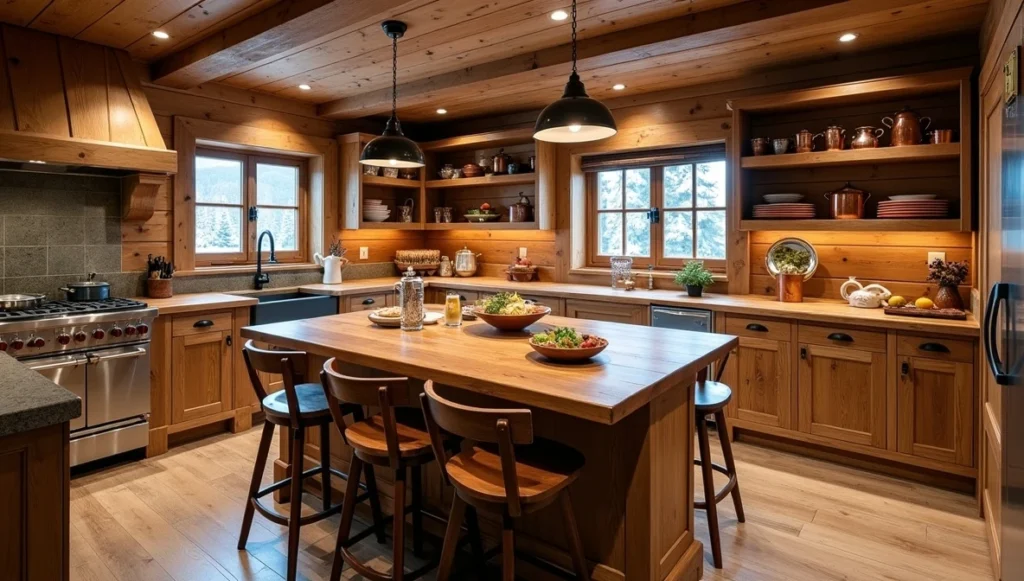
Bathrooms as Mountain Spas
Alpine bathrooms channel natural hot springs. Stone tile floors with radiant heating underneath. Wooden vanities made from thick slabs. Clawfoot tubs positioned near windows for mountain views.
I skip the fancy fixtures in favor of simple, substantial pieces. Bronze or copper faucets that develop patina. Wooden mirrors framed in reclaimed barn wood. Thick cotton towels in natural colors.
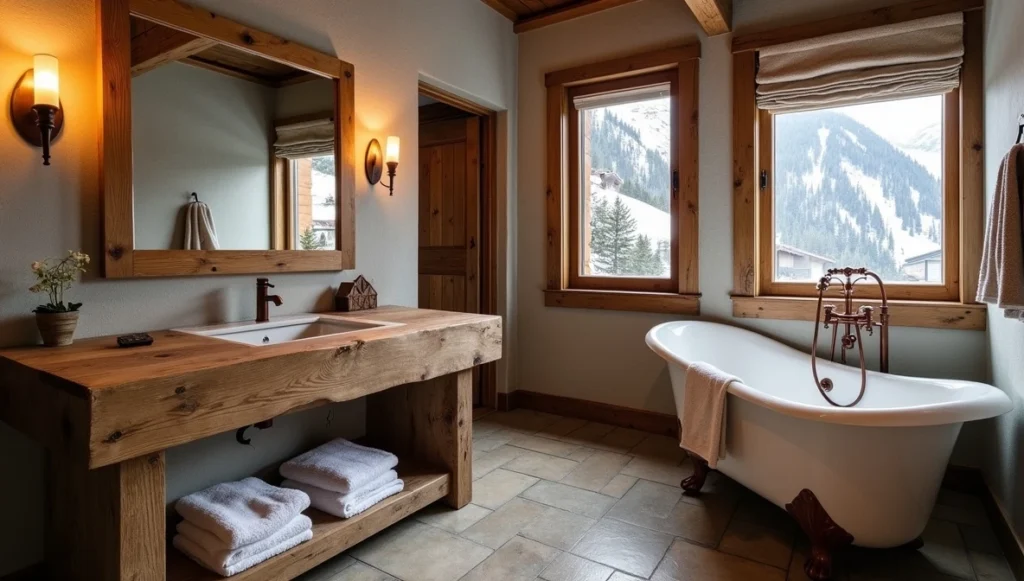
Home Offices That Actually Work
Alpine home offices need to handle real work while maintaining that cozy mountain vibe. I use heavy wooden desks that can support multiple monitors and stacks of paperwork. Built-in shelving from reclaimed wood stores books and supplies.
A comfortable reading chair near the window provides a break from screen time. Warm task lighting prevents eye strain during long winter days when natural light disappears early.
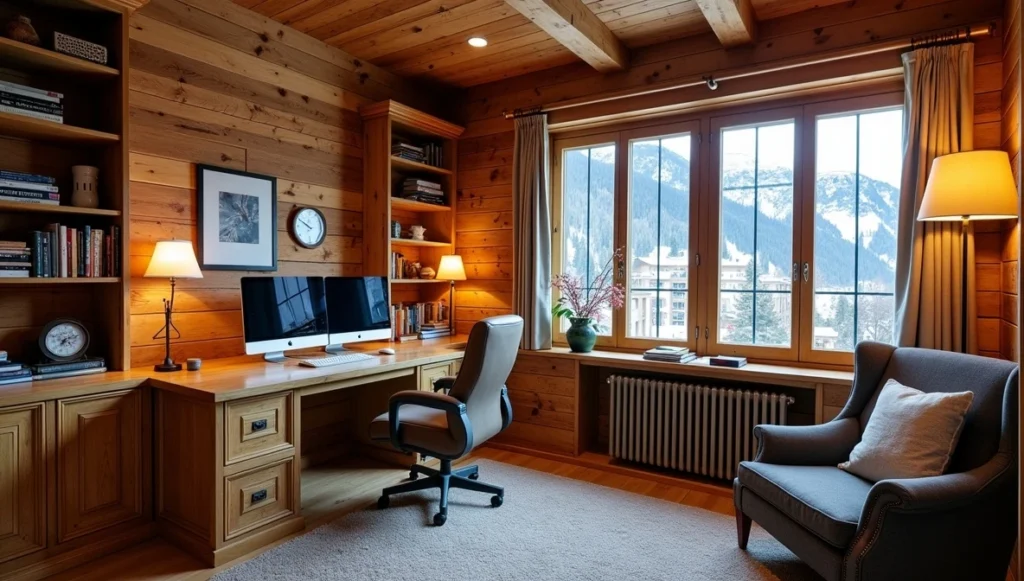
Dining Rooms for Long Meals
Alpine dining rooms expect to host epic meals that stretch for hours. Think Christmas dinners that start at noon and end at midnight. The table needs to handle hot platters, wine spills, and people leaning on it during animated conversations.
I always recommend expandable tables made from thick wood slabs. Bench seating on one side accommodates kids and creates casual vibes. Wooden chairs with rush or leather seats on the other side for adults.
A sideboard or hutch displays serving pieces and stores linens. Nothing fancy, just solid wood construction that’ll last another century.
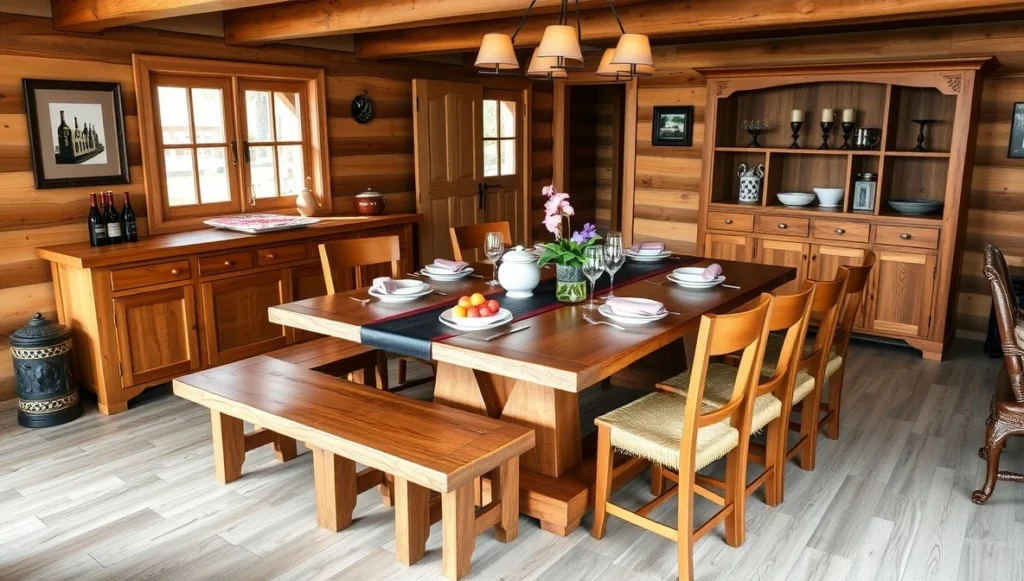
Entryways That Handle Mountain Life
Alpine entryways work harder than any other room. Wet boots, snow-covered coats, skiing gear, hiking equipment. Everything needs a place, and everything needs to dry out.
Built-in benches with storage underneath handle boot removal and gear storage. Wooden coat hooks mounted on reclaimed barn wood planks. Stone or tile floors that won’t get damaged by salt and snow.
I include a large wooden basket for wet gloves and hats. Sounds simple, but it prevents the dreaded pile of soggy winter gear that kills the vibe in every other room.
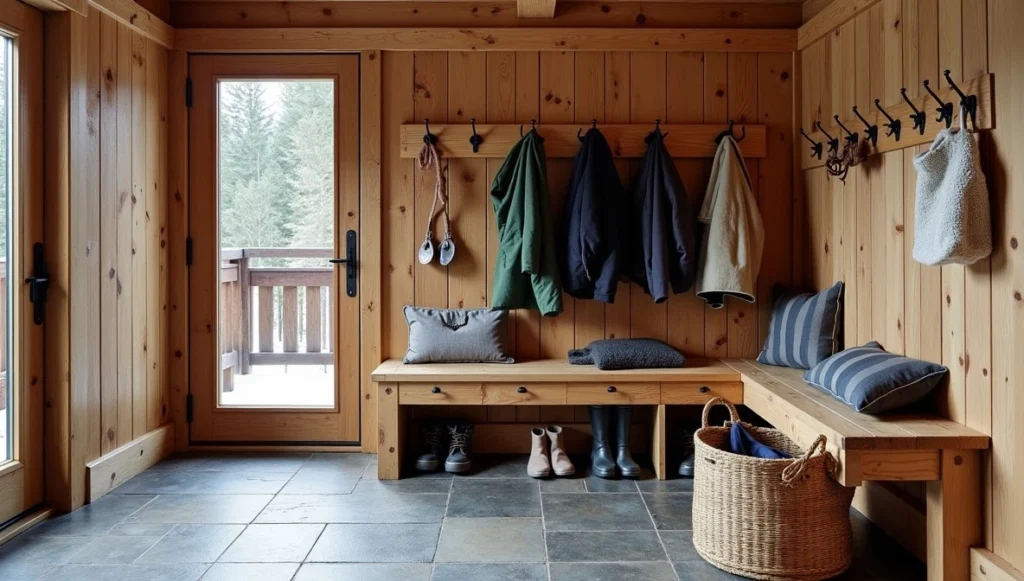
Kids’ Rooms That Spark Adventure
Alpine kids’ rooms should feel like base camp for outdoor adventures. I design these spaces to handle muddy hiking boots, wet swimsuits from lake days, and collections of pinecones and interesting rocks that kids inevitably accumulate.
Built-in bunk beds made from sturdy pine work great for multiple kids or sleepovers. I position them near windows so kids can watch snow fall or spot wildlife. Storage underneath handles sports equipment and outdoor gear.
Wooden toy chests double as seating and craft tables. Cork board walls display trail maps, nature photos, and kids’ artwork. Everything gets built to withstand rougher treatment than typical kids’ furniture faces.
The color palette stays natural but adds playful touches. Maybe a bright red accent wall that mimics classic Alpine shutters. Plaid bedding that references traditional mountain textiles but feels kid-friendly.
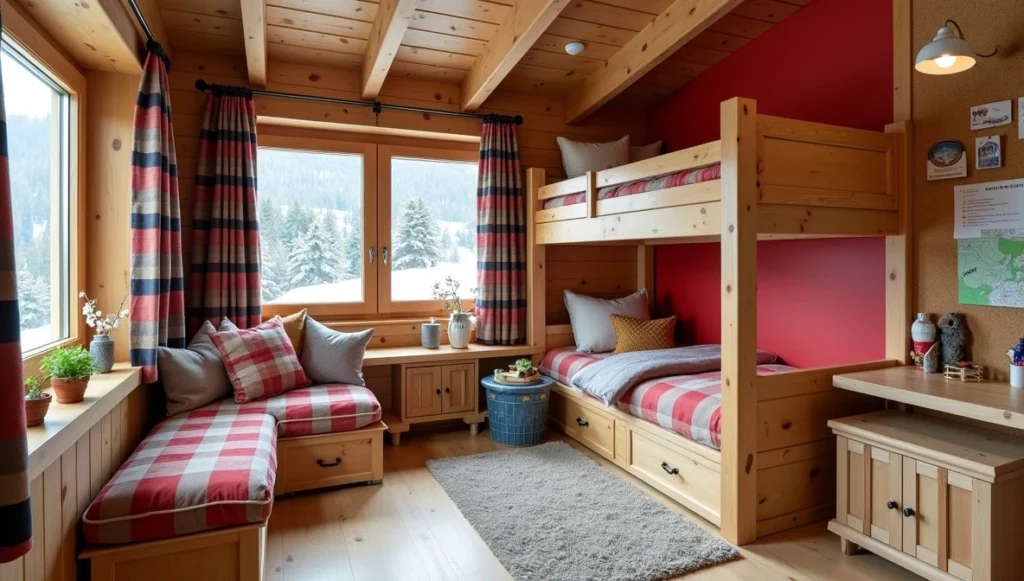
Outdoor Spaces That Extend the Season
Alpine outdoor living pushes the boundaries of when you can actually enjoy being outside. Fire pits or outdoor fireplaces extend the usable season well into fall and early winter.
Heavy wooden furniture that can handle weather extremes. Benches made from tree slabs. Adirondack chairs built from cedar or teak. Everything positioned to take advantage of mountain views while providing wind protection.
I include storage for outdoor blankets and cushions. Mountain weather changes fast, and people need to grab warm gear quickly.
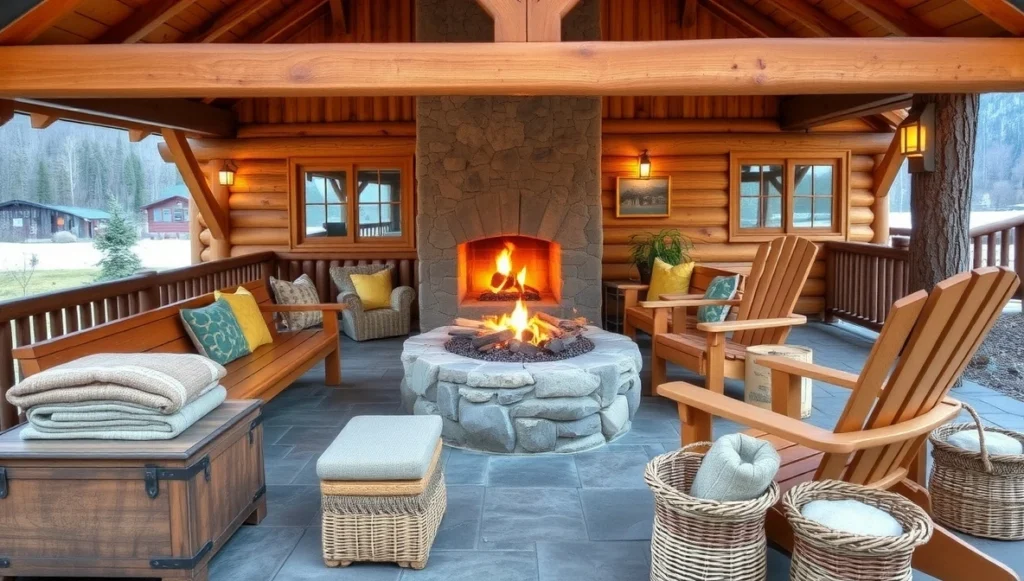
Getting the Details Right
Lighting That Mimics Firelight
Overhead lighting kills Alpine ambiance faster than anything. I rely on table lamps, floor lamps, and wall sconces that create pools of warm light throughout the space.
My favorite trick is installing dimmer switches on everything. Alpine lighting should never feel harsh or clinical. Think candlelight, not office fluorescents.
Window Treatments That Frame the View
Mountain views deserve respect. I use simple linen curtains that frame windows without blocking natural light during the day. Heavy wool drapes layer behind them for insulation and privacy.
Wooden blinds work well too, especially in rustic cherry or walnut that complements the room’s wood tones.
Art and Accessories with Meaning
Alpine wall art tells stories about mountain life. Vintage skiing posters from European resorts. Black and white photography of mountain landscapes. Hand-forged iron wall sculptures.
I avoid anything that screams “I bought this at a ski resort gift shop.” Instead, I hunt for pieces with genuine connection to mountain culture and Alpine traditions.
Sourcing Authentic Alpine Pieces
Where I Actually Shop
European antique markets remain my best source for authentic Alpine furniture. The monthly market in L’Isle-sur-la-Sorgue in France always yields amazing finds. German and Austrian flea markets often have incredible hand-carved pieces.
Closer to home, I’ve found great pieces at estate sales in mountain communities. Aspen, Park City, Jackson Hole. Families moving to smaller homes often sell beautiful Alpine pieces that have been in mountain homes for decades.
Making New Pieces Look Authentic
Sometimes you can’t find authentic vintage pieces, or your budget won’t stretch that far. I work with craftspeople who understand Alpine traditions and can create new pieces using old techniques.
A cabinetmaker in Vermont makes incredible armoires using traditional joinery methods. A metalworker in Colorado forges iron fixtures that look like they came from a 19th-century Alpine village.
The secret is finding artisans who respect the tradition and won’t cut corners with modern shortcuts.
Common Mistakes That Kill the Vibe
Making Everything Too Perfect
Machine-made “Alpine” furniture looks fake because real Alpine pieces show their age and use. I actually distress new pieces sometimes, but carefully. Light sanding on edges that would naturally wear. Tea staining on wood that would have darkened from woodsmoke and handling.
Overdoing the Ski Lodge Theme
Not every Alpine space needs mounted antlers and vintage skis. Some of my best Alpine projects barely reference skiing at all. They focus on the broader mountain living tradition: sturdy construction, natural materials, cozy comfort.
Ignoring Modern Comfort
Historical Alpine living was pretty uncomfortable by today’s standards. Modern Alpine design keeps the aesthetic while adding central heating, proper insulation, and comfortable seating.
I installed radiant floor heating in a Jackson Hole chalet last winter. The homeowner said it made all the difference between feeling like you’re camping and feeling like you’re home.
Why Alpine Chalet Design Works Everywhere
You don’t need mountain views to make Alpine design work. I’ve created beautiful Alpine-inspired spaces in downtown apartments and suburban homes. The style works because it addresses universal human needs: warmth, comfort, connection to natural materials.
A client in Chicago wanted Alpine style in her city condo. We couldn’t change the architecture, but we could bring in the materials and mood. Reclaimed wood accent walls, a stone fireplace surround, thick wool rugs, and warm lighting transformed her modern space into a cozy retreat.
The secret is focusing on how the space feels rather than checking off style boxes. Does it make you want to slow down and relax? Does it feel warm and welcoming? Does it connect you to natural materials and traditional craftsmanship?
If yes, you’ve captured the essence of Alpine chalet design, whether you’re at 8,000 feet or sea level.
